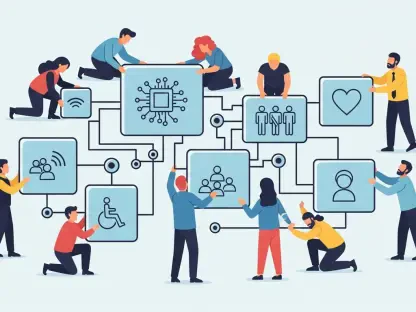Generative AI (GenAI) is revolutionizing the data visualization landscape, streamlining workflows, and democratizing access to insightful data representations. As organizations increasingly rely on data to make informed decisions, the automation and simplification brought about by GenAI are proving to be transformative. The technology’s ability to automate complex tasks and recommend optimal visualization forms allows a broader range of users to engage with data, thus enhancing decision-making processes across all organizational levels. Despite some initial challenges, integrating GenAI into data workflows promises to make data visualization more accessible and efficient.
Automation and Simplification of Data Visualization
Generative AI tools significantly streamline the process of creating data visualizations by automating the generation of charts, graphs, and other visual elements. This automation is a game-changer, especially for those without a deep background in data science or analytics. Previously cumbersome tasks, such as determining the right type of visual for a particular dataset, are simplified as GenAI recommends the most suitable options based on the data’s characteristics. This takes much of the guesswork out of data visualization, allowing users to focus more on interpreting data rather than creating it.Moreover, these tools allow users to bypass the intricate knowledge of data visualization principles, making it easier to produce high-quality visuals. The ease of use enabled by GenAI means that a broader audience within an organization can engage with and understand data, leading to better decision-making across all levels. This democratization of data analysis empowers non-specialists, enhancing their ability to contribute to data-driven discussions and decisions. However, these benefits do come with some initial challenges. Users must still ensure their data is correctly formatted and prepared for analysis. While GenAI tools can automate many steps, early adopters often face a learning curve in understanding how to best utilize these technologies for their specific needs.
Enhanced Data Insights and Analysis
One of the standout features of GenAI in data visualization is its ability to quickly process and analyze large datasets. By doing so, it can identify patterns, trends, and relationships that might not be immediately apparent to human analysts. This capability is pivotal for organizations looking to derive meaningful insights from massive amounts of data. The enhanced analysis capabilities of GenAI mean that businesses can unearth deeper insights faster than ever before, leading to more effective decision-making.Dynamic visualization, where real-time data updates are reflected instantly, is another significant advantage brought by GenAI. This feature supports continuous monitoring and swift responses to emerging trends, although setting up real-time data streams can be technically demanding. The ability to visualize and analyze data in real-time is crucial for industries where timely responses to changes can make a significant difference. Despite these advancements, users must remain mindful of the quality of the data being analyzed. GenAI is powerful, but its outputs are only as good as the data fed into it. Ensuring accurate and relevant data is crucial for deriving reliable insights.
Accelerated Data Exploration
GenAI accelerates the exploration of varied data types, including unstructured data such as text and images, enabling quicker insights. For non-data scientists, especially IT professionals who might not have extensive experience with manual data analysis, this acceleration is immensely beneficial. It reduces the time spent on data manipulation and allows for more immediate exploration and insight generation. The speed at which GenAI can process and present data allows teams to act more promptly on new information, enhancing their agility and competitive edge.The integration of data enrichment processes further enhances the speed and depth of analysis, enabling users to uncover patterns and correlations that would otherwise be missed. This rapid exploration capability is critical in fast-paced business environments where timely insights can significantly influence decision-making and competitive advantage. Nonetheless, the acceleration in data exploration still hinges on the quality and readiness of the data. Proper data preparation is essential, even as GenAI tools continue to evolve to handle a broader range of data formats and inputs.
Feedback Loop in Analytics
The ability of GenAI to transform data insights into actionable steps fosters a valuable feedback loop in data analytics. This loop involves continuously generating new data from actions taken based on initial insights, thereby refining and improving subsequent analyses. Visualizations play a crucial role here by making data comprehensible and highlighting significant anomalies and trends. This closed-loop system ensures that analytics processes are continually enhanced, leading to increasingly refined and actionable insights over time.This feedback loop enhances the overall analysis process, ensuring that organizations can stay agile and responsive. Actions based on clear visual insights lead to better outcomes and, in turn, produce new data that can be analyzed to further refine strategies and decisions. Despite the benefits, continuously maintaining this loop requires diligent attention to data quality and context. Users need a certain level of subject matter expertise to accurately interpret the visualizations and ensure the actions taken are appropriate and effective. The interplay between human expertise and GenAI is vital for optimizing the feedback loop.
Streamlining Analytics Processes
Automation of manual tasks such as data segmentation and categorization through GenAI dramatically enhances productivity. By delegating these routine tasks to AI, data teams can focus on more critical and complex aspects of their work, like hypothesis testing and strategic analysis. This shift not only increases efficiency but also leads to deeper and more insightful analysis efforts, as human resources are freed up to focus on high-value tasks.These streamlined processes mean that data is more efficiently organized and categorized according to specific team responsibilities, leading to improved focus and productivity. Automated processes help in quickly classifying data, allowing for more targeted analysis per the team’s needs. However, users must address the inherent challenges in ensuring these automated processes are set up correctly and that the AI systems are adequately trained. Proper training and continuous monitoring are necessary for these systems to function effectively and deliver accurate results.
Challenges and Constraints
Generative AI (GenAI) is transforming the realm of data visualization, making workflows more efficient and democratizing access to meaningful data representations. As organizations lean heavily on data to drive informed decision-making, the automation and ease brought by GenAI are proving to be game-changing. This advanced technology’s capability to automate intricate tasks and recommend optimal visualization methods enables a wider spectrum of users to interact with data more effectively, thereby boosting decision-making processes at every level within an organization. Even though there are some initial obstacles to overcome, the integration of GenAI into data workflows holds the promise of making data visualization both more accessible and significantly more efficient. By lowering the barrier to entry, GenAI empowers employees across various departments, not just data specialists, to utilize data insights, fostering a more data-literate workforce. The overall effect is a transformative shift in how organizations understand and leverage data, optimizing operations and strategic planning.









